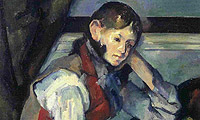
Clean as a Whistler? Interpol launches online art database
Global policing body gives free access to its catalogue of stolen treasuresDetail from Paul Cézanne's The Boy in the Red Vest. The painting was stolen from the Bührle Collection in Zurich in 2008. Photograph: Reuters
The last thing Bond villains and shadowy Mr Bigs want to worry about when buying a piece of art is where it came from. But for consumers who want to be as discerning in their ethics as in their taste, ensuring that their coveted artwork has not been stolen can be tricky.
Now, for the first time, anyone looking to establish the origins of an artwork or simply peruse the vast catalogue of the world's stolen treasures can do so for free at the click of a mouse. Interpol, the global policing body, has unveiled an online database of about 34,000 items known to have gone missing, and it hopes its existence will prove a "crucial step" in the fight against the flourishing illegal trade.
"Accessibility to stolen art information is a vital contribution to creating public awareness on the protection of cultural property," said Karl Heinz Kind, the co-ordinator of the organisation's Works of Art department. "The inclusion of a stolen cultural property item into Interpol's stolen works of art database ... therefore represents an important barrier to the illicit trafficking of a stolen cultural object by making its sale more difficult."
Open to interested individuals as well as governments, museums, galleries and auction houses, the database features masterpieces by artists such as Caravaggio, Titian and Degas as well as a host of other, lesser known paintings, sculptures, pieces of furniture and jewellery. Among the items featured are Cézanne's The Boy in the Red Vest and Rembrandt's The Storm of the Sea of Galilee, which was taken from a US gallery in a 1990 heist considered the biggest in history.
"These are items stolen from all over the world – from Bhutan and Mongolia to the US, Australia and Europe," said an Interpol specialist who did not want his name to be published.
"Having such an accessible record of what's missing is very important because, that way, if you find yourself being offered a Renoir for a fraction of the price, you'll be able to check what you're buying."
With the recent boom in the art market, the illicit trafficking of precious works has flourished and police are searching for better ways to crack down on the key perpetrators.
But in certain countries it remains a fiendishly efficient black market, said the Interpol source. "Belgium is like a turntable: stolen goods disappear immediately."
Since its launch last month, about 400 people have applied for a password to view the site. They will be able to keep track of thefts as they happen, with staff at Interpol's headquarters in Lyon updating the database whenever they receive word of new heists.
But, while experts have welcomed the online database as a big improvement on the previous system, some are pushing for even more drastic measures to be put in place. Arguing that persuading people to come forward with items they know to be stolen is no easy feat, they say incentives should be offered.
 Clean as a Whistler? Interpol launches online art database
Clean as a Whistler? Interpol launches online art database